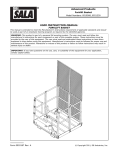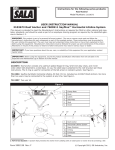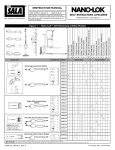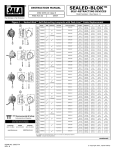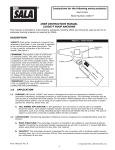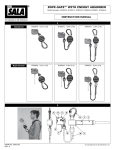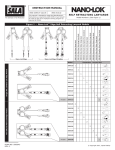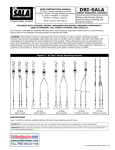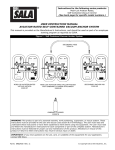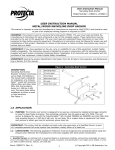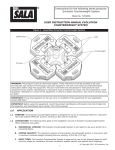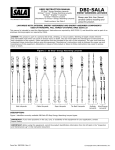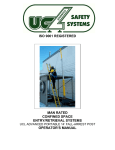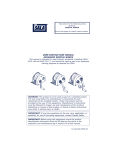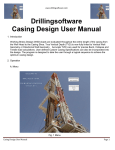Download user instruction manual 8510140 truck hitch mount
Transcript
Instructions for the following series products: 8510140 TRUCK HITCH MOUNT & ACCESSORIES USER INSTRUCTION MANUAL 8510140 TRUCK HITCH MOUNT & ACCESSORIES This manual is intended to meet industry standards and should be used as part of an employee training program as required by OSHA. 12 WARNING: This product is part of a personal fall arrest system1. The user or rescuer2 must read and follow the manufacturer’s instructions for each component or part of the complete system. These instructions must be provided to the user/rescuer utilizing this equipment. The user/rescuer must read and understand these instructions or have them explained to them before using this equipment. Manufacturer’s instructions must be followed for proper use and maintenance of this product. Alterations or misuse of this product or failure to follow instructions may result in serious injury or death. IMPORTANT: If you have questions about the use, care, or suitability of this equipment for your application, contact Capital Safety. IMPORTANT: Before using this equipment, record the product identification information from the ID label in the Inspection and Maintenance Log in Section 9 of this manual. 1. Fall Arrest System: A system that prevents the worker from colliding with an obstruction or lower level by arresting a fall. 2. Rescuer: Person or persons other than the rescue subject acting to perform an assisted rescue by operation of a rescue system. Form: 5903195 Rev: A © Copyright 2011, DB Industries, Inc. 1.0 APPLICATIONS 1.1 PURPOSE: Personal Protective Equipment against falls from a height This system is designed to be used with other Capital Safety equipment to form a fall arrest system. 1.2 1.3 LIMITATIONS: The following limitations must be considered before using this product. Failure to observe product limitations could result in serious injury or death. A. ASSEMBLY: The anchor must be used in accordance with the requirements stated in Section 4. B. PERSONAL FALL ARREST SYSTEMS: Personal Fall Arrest Systems (PFAS) used with the anchor must meet applicable state and federal regulations, or CE regulations, and the requirements stated in this instruction. C. CAPACITY: This system rating is that of the lowest rated component. D. PHYSICAL AND ENVIRONMENTAL HAZARDS: Use of this equipment in areas with physical or environmental hazards may require that additional precautions be taken to reduce the possibility of damage to this equipment or injury to the user. Hazards may include, but are not limited to: high heat (welding or metal cutting), acid or caustic chemicals, corrosive environments such as exposure to seawater, high voltage power lines, electrical hazards, explosive or toxic gases, moving machinery, abrasive surfaces, or sharp edges. Contact Capital Safety if you have questions about the application of this equipment in areas where physical or environmental hazards are present. E. TRAINING: This equipment is to be assembled, installed, and used by persons who have been trained in its correct application and use. STANDARDS: Refer to local standards, national standards, and OSHA requirements, for more information on the application of this and associated equipment. 2.0 SYSTEM REQUIREMENTS 2.1 COMPATIBILITY OF COMPONENTS: Capital Safety equipment is designed for use with Capital Safety approved components and subsystems only. Substitutions or replacements made with non-approved components or subsystems may jeopardize compatibility of equipment and may effect the safety and reliability of the complete system. 2.2 COMPATIBILITY OF CONNECTORS: Connectors are considered to be compatible with connecting elements when they have been designed to work together in such a way that their sizes and shapes do not cause their gate mechanisms to inadvertently open regardless of how they become oriented. Contact Capital Safety if you have any questions about compatibility. Connectors (hooks, carabiners, and D-rings) must be capable of supporting at least 5,000 lbs (22.2kN). Connectors must be compatible with the anchorage or other system components. Do not use equipment that is not compatible. Non-compatible connectors may unintentionally disengage (see Figure 1). Connectors must be compatible in size, shape, and strength. Self-locking snap hooks and carabiners are required by OSHA. 2.3 CONNECTIONS: Only use self-locking snap hooks and carabiners with this equipment. Only use connectors that are suitable to each application. Ensure all connections are compatible in size, shape, and strength. Do not use equipment that is not compatible. Ensure all connectors are fully closed and locked. Capital Safety connectors (snap hooks and carabiners) are designed to be used only as specified in each product’s user instructions. See Figure 2 for inappropriate connections. Capital Safety snap hooks and carabiners should not be connected: A. To a D-ring to which another connector is attached. B. In a manner that would result in a load on the gate. NOTE: Large throat snap hooks should not be connected to standard size D-rings or similar objects which will result in a load on the gate if the hook or D-ring twists or rotates. Large throat snap hooks are designed for use on fixed structural elements such as rebar or cross members that are not shaped in a way that can capture the gate of the hook. C. In a false engagement, where features that protrude from the snap hook or carabiner catch on the anchor, and without visual confirmation seems to be fully engaged to the anchor point. 2 D. To each other. E. Directly to webbing or rope lanyard or tieback (unless the manufacturer’s instructions for both the lanyard and connector specifically allows such a connection). F. To any object which is shaped or dimensioned such that the snap hook or carabiner will not close and lock, or that roll-out could occur. Figure 1 - Unintentional Disengagement (Rollout) If the connecting element to which a snap hook (shown) or carabiner attaches is undersized or irregular in shape, a situation could occur where the connecting element applies a force to the gate of the snap hook or carabiner. This force may cause the gate (of either a self-locking or a non-locking snap hook) to open, allowing the snap hook or carabiner to disengage from the connecting point. Small ring or other noncompatibly shaped element 1. Force is applied to the snap hook. 2. The gate presses against the connecting ring 3. The gate opens allowing the snap hook to slip off Figure 2 - Inappropriate Connections 3 3.0 ASSEMBLY AND SET UP Step 1. Verify the vehicle has a Class 3 or higher trailer hitch rating that can wtihstand a minimum of 1800 lbs. (8 kN). Step 2. If using the hitch ball coupler (8520886), remove pin and place over a 2” (50.8 mm) hitch ball. Replace pin directly behind the hitch ball and fasten down the tri-screw. See Figure 3 Step 3. Insert the hitch tube assembly into the vehicle reciever tube, hitch mount sleeve extension, or hitch ball coupler and secure with bolt or Class 3 vehicle hitch pin. This system can be used with a maximum of one sleeve extension up to a maximum total (truck hitch mount, extension, and coupler) of 10’ (3048 mm). Step 4. Insert the height adjustment tube into the hitch tube assembly and secure with pin so the height adjustment tube is portruding out the bottom. Step 5. Install foot assembly on to the height adjustment tube and secure with pin. Step 6. Level the assembly by removing the height adjustment tube pin and selecting higher or lower hole as per required. Step 7. Insert davit and/or mast extensions. This system is designed to be used with a davit having a maximum of a 30” (762 mm) reach and a maximum of one davit mast extension up to a maximum of 24” (610mm). Figure 3 - Installation of Hitch Ball Coupler Hitch Ball Tri-Screw Pin Bolt or Class 3 Hitch Pin 4 Figure 4 - Installing the Anchor Hitch Ball Coupler or Vehicle Reciever Tube Height Adjustment Tube Bolt or Class 3 Hitch Pin Hitch Tube Assembly Foot Assembly 4.0 OPERATION AND USE WARNING: Do not alter or intentionally misuse this equipment. WARNING: Consult Capital Safety when using this equipment in combination with components or subsystems other than those described in this manual. Some subsystem and component combinations may interfere with the operation of this equipment. Use caution when using this equipment around moving machinery, electrical hazards, chemical hazards, and sharp edges. WARNING: Working at height has inherent risks. Some risks are noted here but are not limited to the following: falling, suspension/prolonged suspension, striking objects, and unconsciousness. In the event of a fall arrest and/or subsequent rescue (emergency) situation, some personal medical conditions may affect your safety. Medical conditions identified as risky for this type of activity include but are not limited to the following: heart disease, high blood pressure, vertigo, epilepsy, drug or alcohol dependence, psychiatric illness, impaired limb function, and balance issues. We recommend that your employer/physician determine if you are fit to handle normal and emergency use of this equipment. 4.1 BEFORE EACH USE: Inspect this equipment carefully to ensure it is in good working condition. Check for worn or damaged parts. Ensure all parts are present and secure. Check the entire system for damage and corrosion. See Section 6 for further inspection details. Do not use if inspection reveals an unsafe condition. If the system fails inspection, immediately remove from service and do not use. Contact Capital Safety for information about how to repair the system. 4.2 PLANNING: Plan your system and how it will function before starting your work. Consider all factors that affect your safety during use. Some important points to consider when planning your system are: A. HAZARD EVALUATION: Evaluate job site hazards prior to starting work. Consult applicable OSHA and industry standards for guidelines and regulatory requirements on equipment such as personal fall arrest systems (PFAS). B. WORK SITE GEOMETRY: The use of this system and attached PFAS must be consistent with the geometric requirements stated in the manufacturer’s instruction manual(s). Check for obstructions or sharp edges in the work path. Avoid working where the user may swing and hit an object, or where lines may cross or tangle with that of another worker. C. FALL CLEARANCE: There must be sufficient clearance in your fall path to prevent striking an object or lower level in the event of a fall. A minimum of 6 ft. (1.8 m) from the working level to the lower level or nearest obstruction is recommended but may vary with your application and attached PFAS. See the PFAS manufacturers’ instructions. D. SWING FALLS: Swing Falls occur when the, anchorage point is not directly overhead (Figure 5). The force of striking an object in a Swing Fall may cause serious injury or death. Minimize Swing Falls by 5 maintaining a work position as directly below the anchorage point as possible. In planning your system, increased clearance is required with Self-Retracting Lifelines or other variable length subsystems to negate the possibility of Swing Falls. E. SHARP EDGES: Avoid working where components of this system and attached subsystem(s) will contact with or abrade against unprotected sharp edges. F. RESCUE: When using this equipment, the employer must have a rescue plan and the means at hand to implement it and communicate that plan to users, authorized persons, and rescuers. G. AFTER A FALL: Any equipment which has been subjected to the forces of arresting a fall or exhibits damage consistent with the effect of fall arrest forces, must be removed from service immediately and destroyed by the user, the rescuer, or an authorized person. Figure 5 - Fall Clearance & Swing Fall Falls Swing Fall Hazard 4.3 REQUIREMENTS FOR PERSONAL FALL ARREST SYSTEMS (PFAS): PFAS used with the Anchor must meet applicable OSHA requirements. • The PFAS should be rigged to minimize any potential free fall and never allow a free fall greater than 6 ft. (1.8 m). The PFAS used with this equipment are required to include a full body harness as the body support component. PFAS that incorporate full body harnesses must maintain fall arrest forces below 900 lbs. (4.0 kN) and arrest the fall within 42 in. (1.1 m), CE models must maintain fall arrest forces below 1350 lbs. (6.0 kN) and arrest the fall with in 42 in. (1.1 m).. Body belts, unless incorporated into a full body harness, are not allowed for use with this equipment. A typical PFAS includes a full body harness, connecting subsystem or component (self retracting lifeline or shock absorbing lanyard), and the necessary connectors to couple the system together. • If the system or any equipment has been subjected to the forces of arresting a fall, they must be removed from service immediately. The Anchor should be inspected for any damage before it is put back into service. WARNING: Read and follow manufacturer’s instructions for the personal fall arrest equipment selected for use with the Anchor. IMPORTANT: Body belts are not allowed for free fall situations. Body belts increase the risk of injury during fall arrest in comparison to a full body harness. Limited suspension time and the potential for improperly wearing a body belt may result in added danger to the user’s health. 5.0 TRAINING It is the responsibility of the user to assure they are familiar with these instructions, and are trained in the correct care and use of this equipment. Users must also be aware of the operating characteristics, application limits, and the consequences of improper use of this equipment. 6 IMPORTANT: Training must be conducted without exposing the trainee to a fall hazard. Training should be repeated on a periodic basis. 6.0 INSPECTION IMPORTANT: After the system has been fully installed, perform a complete inspection. Make sure all supplied labels are present and legible. Inspect for loose bolts, cracks, corrosion, or any other type of abnormality. Check all nuts and bolts for proper torque and orientation. Inspect tri-screws and ensure they are tight. FREQUENCY: Before each use, visually inspect per steps listed in this instruction. INSPECTION STEPS: Step 1. Inspect the system for physical damage. Look carefully for any signs of cracks, dents, or deformities in the metal. Make certain the components are not deformed in any way. Step 2. Inspect the system for signs of excessive corrosion. Step 3. Ensure the vehicle hitch is rated for a Class 3 or higher trailer hitch rating. Step 4. Inspect each system component or subsystem (e.g. self-retracting lifeline, full body harness, etc.) per associated manufacturer’s instructions. Step 5. Verify there are no loose nuts and bolts on the system and all pins are in place. Tighten all loose bolts to the proper torque specifications. Step 6. Record the inspection date and results on the inspection log. IMPORTANT: Only Capital Safety or parties authorized in writing may make repairs to this equipment. IMPORTANT: If the system has been subjected to the forces of arresting a fall, remove it from the field of service. After the system has been removed from service, inspect the system to verify it is in proper working order before using the system. 7.0 MAINTENANCE - SERVICING - STORAGE 7.1 CLEANING: Clean the system with a mild soap detergent solution. Excessive build-up of dirt, tar, etc. may prevent the system from working properly. If you have any questions concerning the condition of your system or have any doubt about putting it into service, contact Capital Safety. NOTE: Additional maintenance and servicing procedures (i.e. replacement parts) must be completed by a factory authorized service center. Authorization must be in writing. 7.2 STORAGE: The system is designed to be stored indoors. Store the Anchor in an area that prevents damage. 7 8.0 LABELS The following labels must be present and legible on the Anchor: WARNING This base is to be used only with the following offsets: 6” 12” 18” 24” 30” 36” 48” Pt# 8514755 0086 EN795:1996 CLASS “B” 8515272 REV E 8 9.0 INSPECTION AND MAINTENANCE LOG SERIAL NUMBER: MODEL NUMBER: DATE PURCHASED: INSPECTION DATE DATE OF FIRST USE: INSPECTION ITEMS NOTED CORRECTIVE ACTION Approved By: Approved By: Approved By: Approved By: Approved By: Approved By: Approved By: Approved By: Approved By: Approved By: Approved By: Approved By: Approved By: Approved By: Approved By: Approved By: Approved By: Approved By: 9 MAINTENANCE PERFORMED SERIAL NUMBER: MODEL NUMBER: DATE PURCHASED: INSPECTION DATE DATE OF FIRST USE: INSPECTION ITEMS NOTED CORRECTIVE ACTION Approved By: Approved By: Approved By: Approved By: Approved By: Approved By: Approved By: Approved By: Approved By: Approved By: Approved By: Approved By: Approved By: Approved By: Approved By: Approved By: Approved By: Approved By: 10 MAINTENANCE PERFORMED SERIAL NUMBER: MODEL NUMBER: DATE PURCHASED: INSPECTION DATE DATE OF FIRST USE: INSPECTION ITEMS NOTED CORRECTIVE ACTION Approved By: Approved By: Approved By: Approved By: Approved By: Approved By: Approved By: Approved By: Approved By: Approved By: Approved By: Approved By: Approved By: Approved By: Approved By: Approved By: Approved By: Approved By: 11 MAINTENANCE PERFORMED LIMITED LIFETIME WARRANTY Warranty to End User: D B Industries, Inc., dba CAPITAL SAFETY USA (“CAPITAL SAFETY”) warrants to the original end user (“End User”) that its products are free from defects in materials and workmanship under normal use and service. This warranty extends for the lifetime of the product from the date the product is purchased by the End User, in new and unused condition, from a CAPITAL SAFETY authorized distributor. CAPITAL SAFETY’S entire liability to End User and End User’s exclusive remedy under this warranty is limited to the repair or replacement in kind of any defective product within its lifetime (as CAPITAL SAFETY in its sole discretion determines and deems appropriate). No oral or written information or advice given by CAPITAL SAFETY, its distributors, directors, officers, agents or employees shall create any different or additional warranties or in any way increase the scope of this warranty. CAPITAL SAFETY will not accept liability for defects that are the result of product abuse, misuse, alteration or modification, or for defects that are due to a failure to install, maintain, or use the product in accordance with the manufacturer’s instructions. CAPITAL SAFETY’S WARRANTY APPLIES ONLY TO THE END USER. THIS WARRANTY IS THE ONLY WARRANTY APPLICABLE TO OUR PRODUCTS AND IS IN LIEU OF ALL OTHER WARRANTIES AND LIABILITIES, EXPRESSED OR IMPLIED. CAPITAL SAFETY EXPRESSLY EXCLUDES AND DISCLAIMS ANY IMPLIED WARRANTIES OF MERCHANTABILITY OR FITNESS FOR A PARTICULAR PURPOSE, AND SHALL NOT BE LIABLE FOR INCIDENTAL, PUNITIVE OR CONSEQUENTIAL DAMAGES OF ANY NATURE, INCLUDING WITHOUT LIMITATION, LOST PROFITS, REVENUES, OR PRODUCTIVITY, OR FOR BODILY INJURY OR DEATH OR LOSS OR DAMAGE TO PROPERTY, UNDER ANY THEORY OF LIABILITY, INCLUDING WITHOUT LIMITATION, CONTRACT, WARRANTY, STRICT LIABILITY, TORT (INCLUDING NEGLIGENCE) OR OTHER LEGAL OR EQUITABLE THEORY. The Ultimate in Fall Protection CSG USA & Latin America 3833 SALA Way Red Wing, MN 55066-5005 Toll Free: 800.328.6146 Phone: 651.388.8282 Fax: 651.388.5065 [email protected] CSG Canada 260 Export Boulevard Mississauga, ON L5S 1Y9 Phone: 905.795.9333 Toll-Free: 800.387.7484 Fax: 888.387.7484 [email protected] CSG Northern Europe 5a Merse Road North Moons, Moat Reditch, Worcestershire, UK B98 9HL Phone: + 44 (0)1527 548 000 Fax: + 44 (0)1527 591 000 [email protected] CSG EMEA (Europe, Middle East, Africa) Le Broc Center Z.I. 1ère Avenue 5600 M B.P. 15 06511 Carros Le Broc Cedex France Phone: + 33 4 97 10 00 10 Fax: + 33 4 93 08 79 70 [email protected] CSG Australia & New Zealand 95 Derby Street Silverwater Sydney NSW 2128 AUSTRALIA Phone: +(61) 2 8753 7600 Toll-Free : 1 800 245 002 (AUS) Toll-Free : 0800 212 505 (NZ) Fax: +(61) 2 87853 7603 [email protected] CSG Asia Singapore: 16S, Enterprise Road Singapore 627666 Phone: +65 - 65587758 Fax: +65 - 65587058 [email protected] www.capitalsafety.com I S O 9001 Certificate No. FM 39709 Shanghai: Rm 1406, China Venturetech Plaza 819 Nan Jing Xi Rd, Shanghai 200041, P R China Phone: +86 21 62539050 Fax: +86 21 62539060













